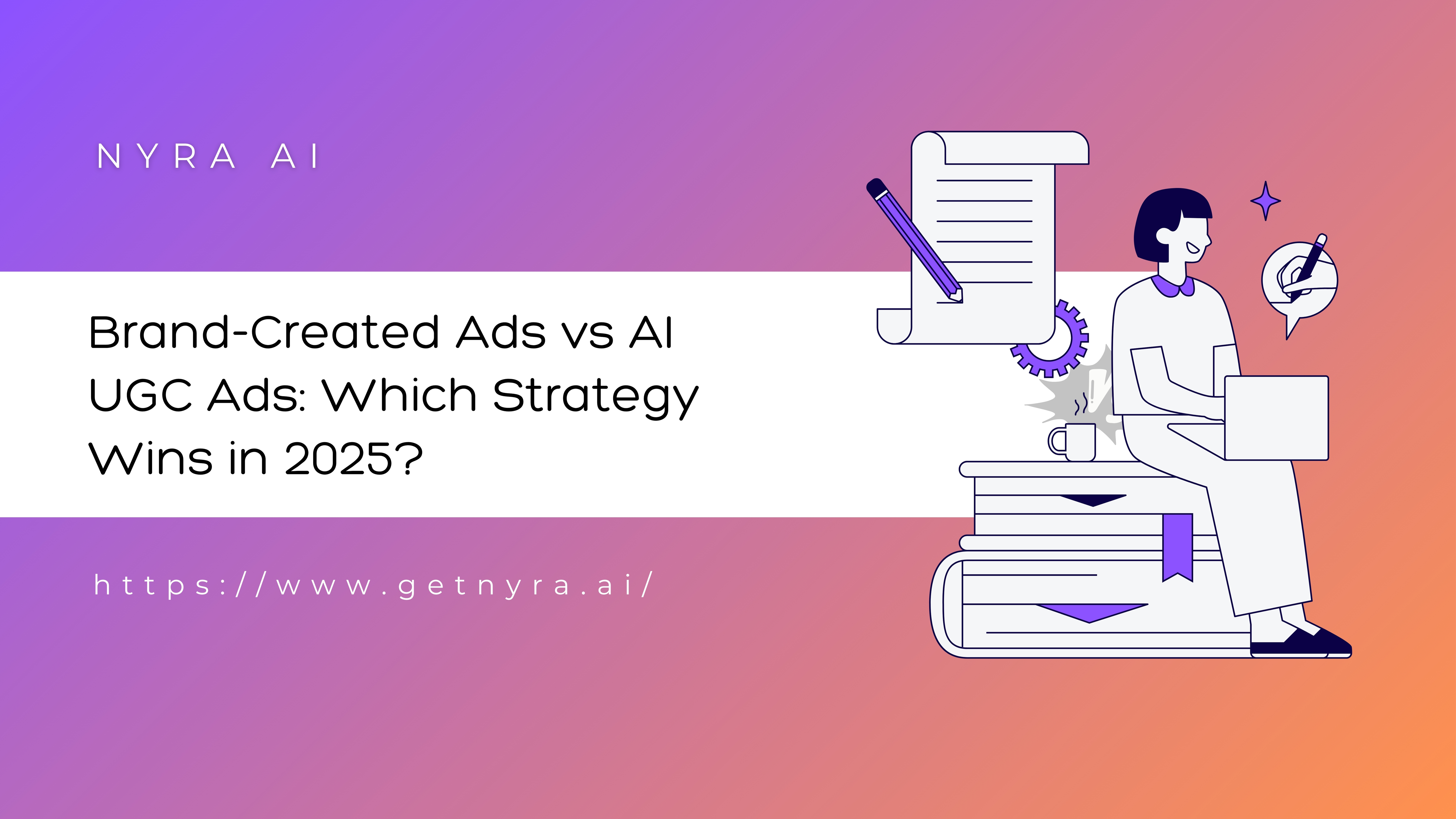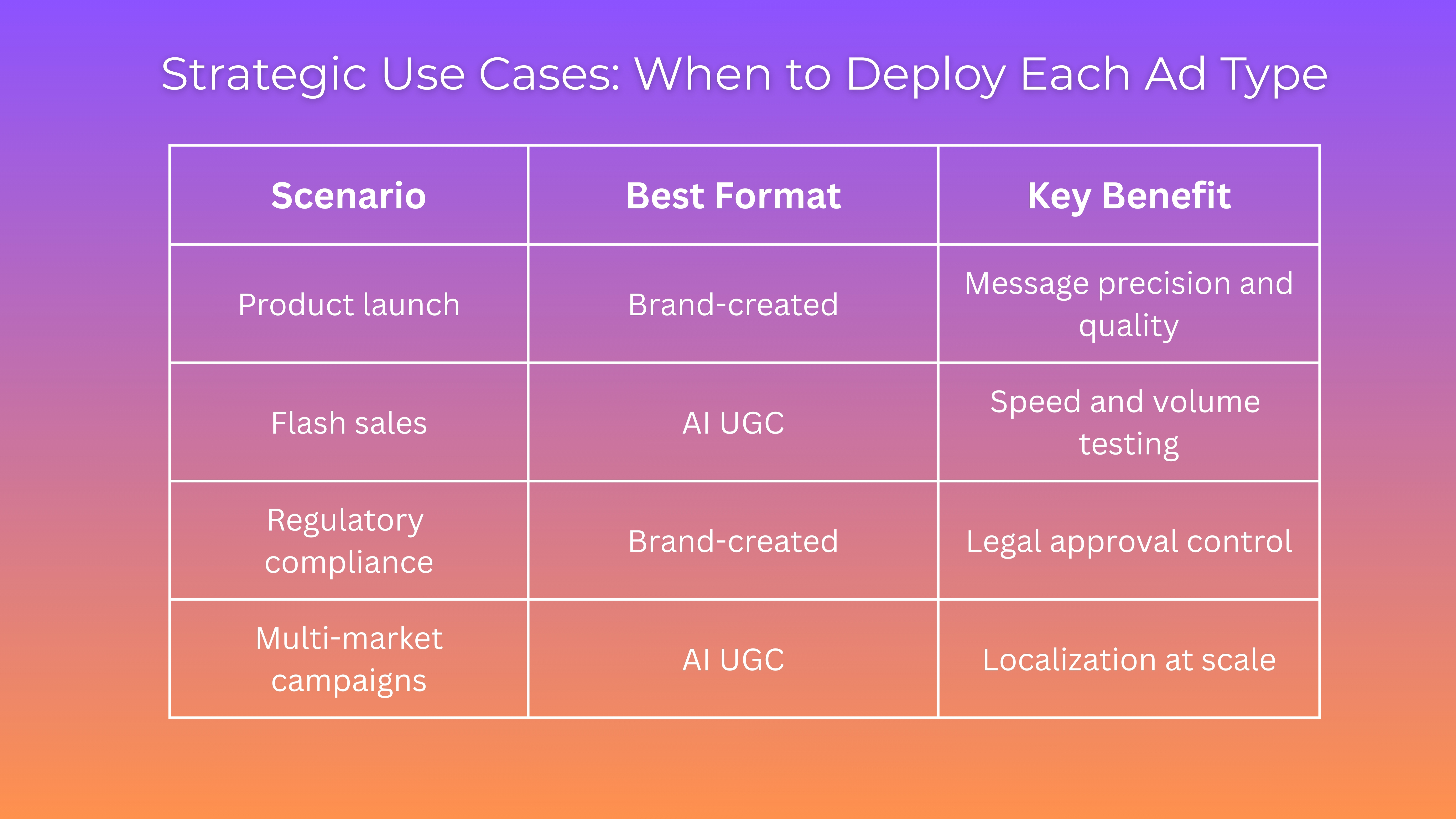Brand-Created Ads vs AI UGC Ads: Which Strategy Wins in 2025?

Choosing between brand-created ads and AI UGC ads can make or break your marketing ROI. While traditional brand ads offer polish and control, AI-powered user-generated content delivers speed and authenticity. This guide reveals which format drives better engagement, conversions, and cost efficiency for your business.
What Are Brand-Created Ads and How Do They Work?
Brand-created ads are professionally produced marketing content crafted by creative teams, including directors, videographers, and editors. These ads follow scripted narratives with studio-grade production quality.
The creation process involves strategic planning, scriptwriting, professional shoots, and extensive post-production. Production cycles typically span three to eight weeks with budgets ranging from $25,000 to $100,000 per asset.
- Production timeline: Multiple approval layers with 3–8 week turnaround times
- Creative control: Total message precision with scripted storytelling and brand alignment
Understanding AI UGC Ads and Their Technology
AI UGC ads are artificially generated content that simulates authentic user testimonials and reviews. Platforms like Zeely AI and Synthesia create video, image, and text-based ads that mimic real customer voices without filming actual people.
These tools use advanced algorithms trained on human speech patterns and behavior. You input a script, select an avatar style, and receive platform-ready content within 48–72 hours.
- Automated production: Generate dozens of customized testimonials without hiring actors or booking studios
- Instant scalability: Create multilingual variants and platform-specific formats from a single source file
Cost and Speed Comparison: Breaking Down the Numbers
Production costs and timelines differ dramatically between traditional and AI-powered approaches. Understanding these financial implications helps determine the right investment for your marketing goals.

A direct-to-consumer skincare brand replaced sixty percent of manual creatives with AI variants, achieving a twenty-nine percent ROAS increase and thirty-eight percent faster production cycles.
Performance Metrics: Which Format Delivers Better ROI?
Performance data reveals clear strengths for each format across different funnel stages. AI UGC campaigns consistently show twenty-eight percent lower cost-per-result and thirty-one percent lower cost-per-acquisition on paid social platforms.
Brand-created ads excel in top-of-funnel awareness with twenty to forty percent higher brand recall rates. Premium industries like finance and luxury see thirty percent better brand lift metrics with professionally produced content.
- Bottom-funnel conversion: AI UGC dominates with superior click-through rates and conversion efficiency
- Brand awareness: Traditional ads maintain strength in storytelling and prestige positioning
Strategic Use Cases: When to Deploy Each Ad Type

Choose brand-created ads for high-stakes campaigns requiring cinematic quality and stakeholder approval. Deploy AI UGC for performance marketing, rapid testing, and always-on social campaigns where agility outweighs polish.
Hybrid Advertising Strategies for Maximum Impact
Leading marketers combine both formats to balance control with scalability. A hybrid approach uses professionally shot hero videos for YouTube and television while deploying AI-generated testimonials across Meta, TikTok, and email retargeting.
One lifestyle brand paired their flagship film with Zeely-powered UGC variants, achieving a thirty-seven percent CPA reduction and 2.4x ROAS increase. This orchestration maintains brand tone while activating community-scale relevance.
- Campaign structure: Professional anchor content for awareness, AI variants for conversion optimization
- Funnel mapping: Polished top-of-funnel touchpoints with AI-driven mid and bottom-funnel testing
Future Trends Reshaping Digital Ad Production
Real-time content generation is becoming standard practice. Tools now adjust voice, visuals, and calls-to-action automatically based on audience response data. Regulatory frameworks like the EU AI Act require transparent labeling of synthetic content, making compliance-by-design essential.
Predictive creative testing allows brands to generate thirty or more variants simultaneously. One global retailer achieved a nineteen percent engagement lift using AI-powered multivariate testing with twenty-two percent faster launch cycles.
Frequently Asked Questions
Q1. What is the main difference between brand-created ads and AI UGC ads?
Brand-created ads are professionally produced with scripted narratives and studio quality, costing $25,000–$100,000 and taking 4–8 weeks. AI UGC ads are algorithm-generated testimonials that cost $2,000–$5,000 and launch within 2–3 days, simulating authentic user content at scale.
Q2. Which ad format has better conversion rates?
AI UGC ads typically deliver 28% lower cost-per-result and 31% lower cost-per-acquisition for bottom-funnel conversions on social platforms. Brand-created ads perform 30% better for top-funnel awareness and brand recall, especially in premium categories requiring high production quality.
Q3. Can I use both brand-created and AI UGC ads together?
Absolutely. Hybrid strategies combine professional hero content for brand positioning with AI-generated variants for performance testing. Brands using this approach report 37% lower CPA and 2.4x higher ROAS while maintaining message consistency across all customer touchpoints.
Q4. Are AI UGC ads compliant with advertising regulations?
Yes, when properly labeled. Regulations like the EU AI Act and FTC guidelines require transparent disclosure of AI-generated content. Platforms like Zeely AI include built-in compliance features ensuring ads meet current regulatory standards while maintaining authentic delivery and brand safety.